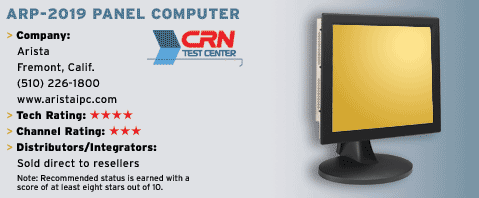Arista's New Rugged Panel PC Goes Where Conventional PCs Can't
The demands of industrial and public locations drive the need for "hardened" systems—ruggedized PCs that can stand up to abuse. In that environment, that also includes monitors.
Combining a rugged display with a rugged PC is the logical choice for harsh environments. Taking that one step further is Arista, with its ARP-2019 rugged panel PC that can be flush-mounted on a wall.
CRN Test Center engineers took a look at Arista's new 19-inch panel PC, which is ideal for supervisory control applications, information kiosks, POS terminals and more.
Solution providers can use this as the basis for any number of custom computing solutions, as this is one PC that is suitable for several vertical markets.
The ARP-2019 is an entire Pentium 4 computer housed inside the chassis of a 19-inch LCD. The rugged chassis is made of steel and is not intended to be seen. With its shallow 3.75-inch depth, the ARP-2019 is designed to mount flush on a wall. A black aluminum bezel forms a frame around the screen when wall-mounted.
The VESA-compliant chassis also allows mounting the display on any standard mount. In fact, the unit tested came with an optional tilt/swivel/pivot stand, which costs $65. Solution providers also can use any standard VESA base or mounting arm.
The ARP-2019's 19-inch display has a native resolution of 1,280 x 1,024. The computer can come with a resistive touch screen for applications for which users will not have a mouse or keyboard. The touch screen makes the panel computer quite useful for industrial monitoring, information kiosks and POS terminals. The touch-screen option costs $250.
The ARP-2019 panel computer reviewed by Test Center engineers contained a 2.4GHz Intel Pentium 4 processor and 512 Mbytes of memory, although the system can handle as much as 1 Gbyte of memory.
The unit can be ordered with a Pentium M processor instead of a Pentium 4 for applications in which power consumption is an issue. The Pentium M processor also supports dual displays, so solution providers will want to go with a Pentium M-based unit for any application in which dual displays will be used.
The display is driven by an Intel Extreme Graphics controller with up to 64 Mbytes of shared memory. Intended to be hidden, the ARP-2019 panel computer's steel chassis is very industrial-looking. All ports and plugs are situated along the bottom edge of the chassis and on the back.
The left side of the chassis houses a notebook-style DVD/CD-RW combo drive, which is not accessible to public users and can only be accessed from inside the kiosk or behind the wall where the panel is installed.
The ARP-2019 panel computer has one PCI expansion slot, so solution providers can add any needed peripheral such as a wireless NIC.
The ARP-2019 system does include one RJ-45 10/100 Ethernet port so it can be connected to a network right out of the box. The panel computer also features a 20-Gbyte, 2.5-inch IDE hard drive, four USB 2.0 ports and up to four RS-232 COM ports.
Industrial control applications tend to use a lot of legacy hardware and RS-232 communication, so the four COM ports might actually be needed.
Other ports include keyboard and mouse, one parallel, one VGA, composite video out and audio.
The unit does not have built-in speakers, though Test Center engineers feel it really should.
Arista's channel program has been in existence for three years. The company sells through three channels: OEMs, systems integrators and distributors. Large OEMs are separate from the distribution channel. Arista directs smaller OEMs and systems integrator business to automation distributors.
The company determines partner level by product and market, with different pricing structures for each partner.
Solution provider margins average 25 percent for the panel computer, and when matched with installation and software services, the units can prove to be quite profitable for resellers.
